DPP4
-
Official Full Name
dipeptidyl-peptidase 4 -
Overview
The protein encoded by this gene is identical to adenosine deaminase complexing protein-2, and to the T-cell activation antigen CD26. It is an intrinsic membrane glycoprotein and a serine exopeptidase that cleaves X-proline dipeptides from the N-terminus of polypeptides. [provided by RefSeq, Jul 2008] -
Synonyms
DPP4;dipeptidyl-peptidase 4;CD26;ADABP;ADCP2;DPPIV;TP103;dipeptidyl peptidase 4;ADCP-2;DPP IV;dipeptidylpeptidase 4;dipeptidyl peptidase IV;T-cell activation antigen CD26;adenosine deaminase complexing protein 2;dipeptidylpeptidase IV (CD26, adenosine deaminase complexing protein 2)
Recombinant Proteins
- Human
- Mouse
- Cynomolgus
- Rhesus macaque
- Rat
- Chicken
- Zebrafish
- Bovine
- Sus scrofa (Pig)
- HEK293
- Human
- Human Cells
- E.coli
- Mammalian Cells
- Hi-5 Insect Cells
- Human Placenta
- Insect Cells
- S.frugiperda
- CHO
- In Vitro Cell Free System
- Yeast
- Fc
- Non
- Avi
- His
- SUMO
- DDK
- Myc
- GST
- Flag
Background
What is DPP4 protein?
DPP4 (dipeptidyl peptidase 4) gene is a protein coding gene which situated on the long arm of chromosome 2 at locus 2q24. The protein encoded by this gene is identical to adenosine deaminase complexing protein-2, and to the T-cell activation antigen CD26. It is an intrinsic membrane glycoprotein and a serine exopeptidase that cleaves X-proline dipeptides from the N-terminus of polypeptides. The DPP4 protein is consisted of 766 amino acids and its molecular mass is approximately 88.3 kDa.
What is the function of DPP4 protein?
DPP-4 is a widely present enzyme in the human body that is expressed in a variety of tissues, especially in the liver, pancreas, intestine, kidneys, and immune cells. DPP-4 can break down the n-terminal dipeptides of certain growth factors and cytokines, thereby reducing the biological activity of these molecules. For example, it can break down glucagon-like peptide-1 (GLP-1) and gastric inhibitory peptide (GIP). And it may be involved in the promotion of lymphatic endothelial cells adhesion, migration and tube formation. It also regulates the immune response.
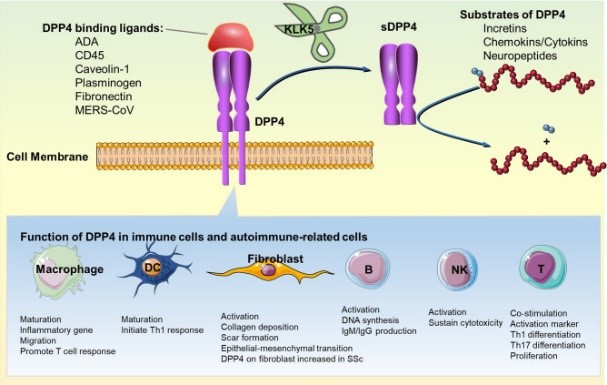
Fig1. Immunoregulatory function of DPP4: enzymatic and non-enzymatic functions of DPP4 in immune cells and fibroblast are shown. (Mingrui Li, 2022)
DPP4 Related Signaling Pathway
The most important pathway of DPP-4 is related to metabolic regulation. It regulates the bioactivity and stability of insulin-like growth factor in islets and other tissues, while it affects blood sugar levels by degrading glucagon-like peptide-1 (GLP-1) and glucagon-like peptide-2 (GLP-2). In addition, DPP-4 also has effects on NF-κB, PI3K/Akt, MAPK/Erk signaling pathways and oxidative stress of adipocytes.
DPP4 Related Diseases
The increased activity of DPP-4 in patients with hyperglycemia and diabetes leads to increased degradation of GLP-1, which reduces insulin secretion and inhibits insulin action. Other diseases associated with abnormal DPP-4 activity include nasopharyngitis, hepatitis, osteoporosis, asthma, and tumors.
Bioapplications of DPP4
Inhibitors of DPP-4 are a class of commonly used anti-diabetic drugs, and their mechanism of action is to reduce blood sugar by inhibiting the activity of DPP-4, thereby increasing the concentration of GLP-1 and GIP, two intestinal hormones that stimulate insulin secretion and inhibit glucagon secretion. These drugs include sitagliptin, vildagliptin, linagliptin and others.
Case Study
Case Study 1: Isabelle M E Lacroix, 2015
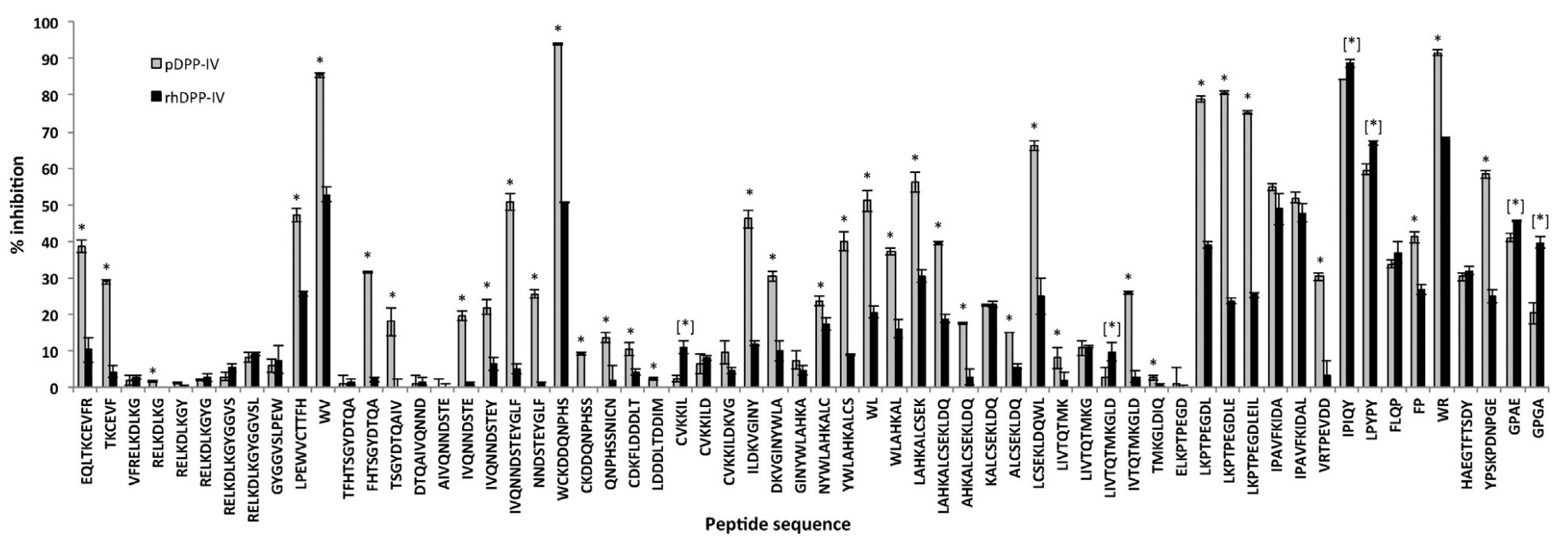
Fig1. Percent inhibition of porcine (p) and recombinant human (rh) DPP-IV activities by synthesized peptides.
Case Study 2: Isabelle M E Lacroix, 2014
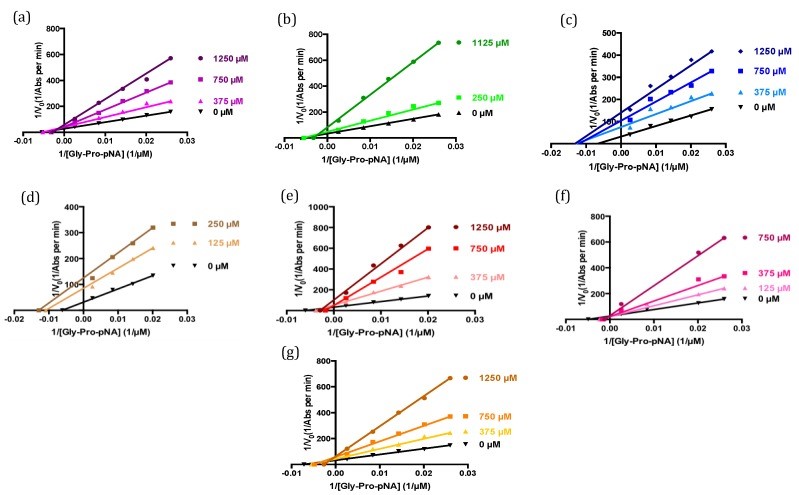
Fig2. Lineweaver-Burk plots of DPP-IV activity in the absence and presence of peptides. (a) LPEWVCTTFH; (b) LAHKALCSEK; (c) LKPTPEGDLE; (d) WCKDDQNPHS; (e) LCSEKLDQWL; (f) IPAVFKIDAL; (g) YPSKPDNPGE.
Quality Guarantee
High Purity
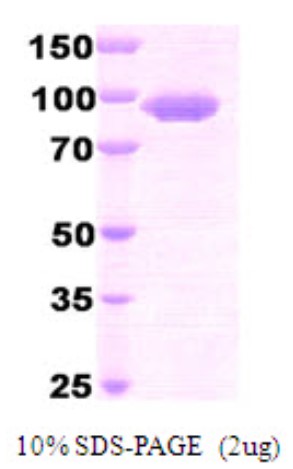
Fig1. SDS-PAGE (DPP4-116H) (PROTOCOL for western blot)
.
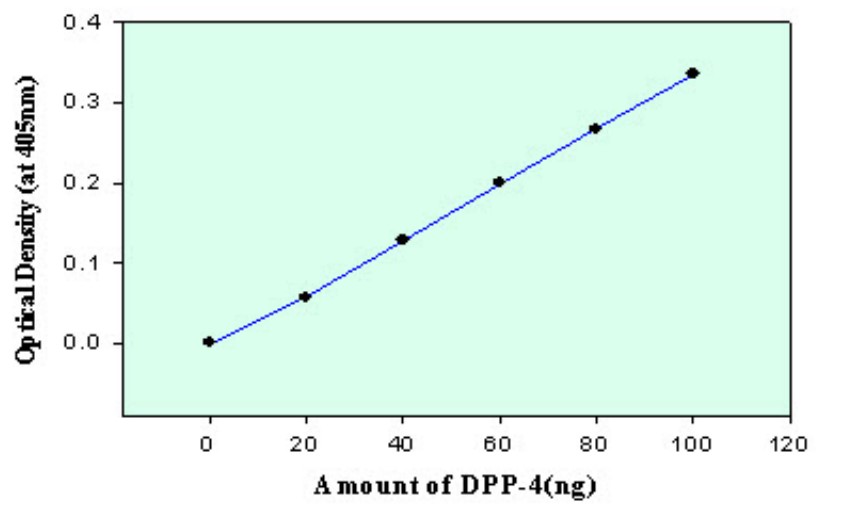
Fig2. Activity Data. (DPP4-008H)
Involved Pathway
DPP4 involved in several pathways and played different roles in them. We selected most pathways DPP4 participated on our site, such as Incretin synthesis, secretion, and inactivation,Metabolism of proteins,Peptide hormone metabolism, which may be useful for your reference. Also, other proteins which involved in the same pathway with DPP4 were listed below. Creative BioMart supplied nearly all the proteins listed, you can search them on our site.
| Pathway Name | Pathway Related Protein |
|---|---|
| Protein digestion and absorption | PRCP,KCNN4,SLC8A1,COL6A6,MEP1A,SLC1A1,CPA3,SLC1A5,COL7A1,ATP1A3 |
| Peptide hormone metabolism | SLC30A6,CPE,INHA,RAB27A,CGB5,CPB2,GRP,CPB1,O3far1,EXOC8 |
| Synthesis, secretion, and inactivation of Glucose-dependent Insulinotropic Polypeptide (GIP) | GPR119,PCSK1 |
| Metabolism of proteins | FBXW5,ZDHHC2,TGFBI,PCSK2,PMPCB,SERP1,SLC38A8,TIMM50,NAT8,MUCL1 |
| Incretin synthesis, secretion, and inactivation | GRP,GPR119,PCSK1,O3far1,SPCS3,SLC38A8,GPR120,CDX2 |
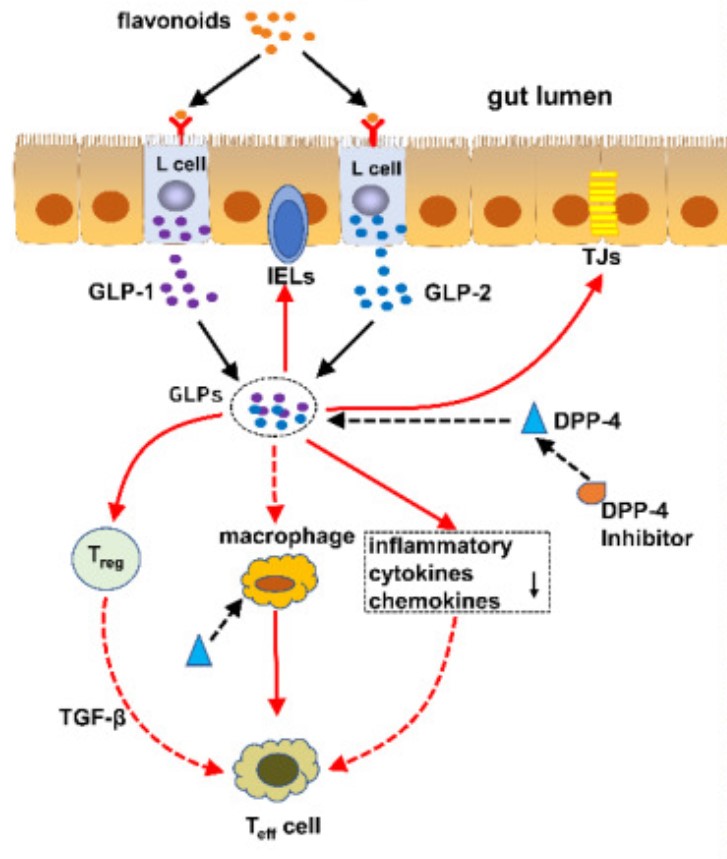
Fig2. Flavonoids regulate IBD by the DPP-4/GLPs pathway: (1) protecting the intestinal barrier, (2) modulating Treg and intraepithelial lymphocytes (IELs) by managing their differentiation and functions and (3) adjusting the function of macrophages and dendritic cells. (Mingrui Li, 2022)
Protein Function
DPP4 has several biochemical functions, for example, dipeptidyl-peptidase activity,identical protein binding,protease binding. Some of the functions are cooperated with other proteins, some of the functions could acted by DPP4 itself. We selected most functions DPP4 had, and list some proteins which have the same functions with DPP4. You can find most of the proteins on our site.
| Function | Related Protein |
|---|---|
| dipeptidyl-peptidase activity | DPP3,NAALAD2,DPP8,DPEP1,PRCP,FAP,DPEP3,DPP7,DPEP2 |
| serine-type endopeptidase activity | CELA1,OVCH2,PCSK1,HP,PRSS7,CTSG,ELA3L,HABP2,PRSS42,KLKB1 |
| serine-type peptidase activity | Acr,F7,ZFYVE9,IMMP2L,KLK1B26,KLK1B1,HTRA1,KLK11,FURINB,KLK4 |
| protein homodimerization activity | ABCD2,IL6R,MAP3K9,FLRT3,THRA,UGT1A6B,ZBTB4,SERPINF2,ATP2A1,FOXP2 |
| receptor binding | TRIM24,KCNA5,DVL3,FGF13B,CRAT,LHB,Icosl,POU2F1,SSFA2,EFNA1 |
| virus receptor activity | CXCR4,ITGB6,PVR,ACE2,NPC1,SERPINB3,RPSA,GPR172B,SCARB2,AXL |
| protein binding | RAD21,C12orf40,ENTPD3,CDC5L,BACE1,HFE2,PDIK1L,RPL10,SRPK2,LRRC8C |
| identical protein binding | ITGA2B,BAX,ST13,DYRK1A,ANXA4,SIAH1,COL7A1,TRA@,APLP1,DIAP1 |
| protease binding | Serpina1b,XBP1,F3,NFRKB,SELL,VWF,TP53,BCL2,TNF,Casp3 |
Interacting Protein
DPP4 has direct interactions with proteins and molecules. Those interactions were detected by several methods such as yeast two hybrid, co-IP, pull-down and so on. We selected proteins and molecules interacted with DPP4 here. Most of them are supplied by our site. Hope this information will be useful for your research of DPP4.
CXCL11;CXCL10;CXCL2;CCL11;CXCL9
Resources
Research Area
Related Services
Related Products
References
- Gierer, S; Muller, MA; et al. Inhibition of Proprotein Convertases Abrogates Processing of the Middle Eastern Respiratory Syndrome Coronavirus Spike Protein in Infected Cells but Does Not Reduce Viral Infectivity. JOURNAL OF INFECTIOUS DISEASES 211:889-897(2015).
- Tiezzi, F; Parker-Gaddis, KL; et al. A Genome-Wide Association Study for Clinical Mastitis in First Parity US Holstein Cows Using Single-Step Approach and Genomic Matrix Re-Weighting Procedure. PLOS ONE 10:-(2015).




